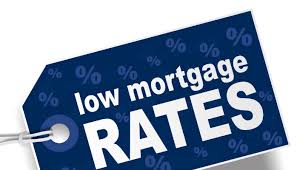Compare current mortgage rates:
In the ever-evolving landscape of personal finance, securing a mortgage with the lowest possible interest rate stands as a crucial goal for many prospective homeowners and refinancers alike. A mortgage represents one of the most significant financial commitments an individual or family can undertake, making the exploration of low mortgage rates a pivotal aspect of financial planning. This article delves into the dynamics of mortgage rates, strategies for securing favorable rates, and considerations for borrowers aiming to optimize their financial position.
Understanding Mortgage Rates:
Compare current mortgage rates refer to the interest charged on a home loan, typically expressed as an annual percentage rate (APR). These rates fluctuate based on a variety of factors, including economic conditions, inflation trends, central bank policies, and market forces. For borrowers, securing a lower mortgage rate translates into reduced monthly payments and overall interest costs over the life of the loan.

Factors Influencing Mortgage Rates:
1. Economic Indicators: Mortgage rates often mirror broader economic indicators such as inflation rates, unemployment levels, and GDP growth. A strong economy tends to push interest rates higher, while economic uncertainty or downturns may lead to lower rates as central banks adjust monetary policies.
2. Central Bank Policies: The decisions and policies of central banks, such as the Federal Reserve in the United States, play a significant role in shaping mortgage rates. Central banks’ actions on interest rates directly impact borrowing costs for financial institutions, which in turn affects consumer mortgage rates.
3. Creditworthiness of Borrowers: Individual borrowers’ credit profiles, including credit scores, income stability, and debt-to-income ratios, influence the interest rates offered to them. Borrowers with higher credit scores and stronger financial profiles typically qualify for lower mortgage rates.
4. Loan Characteristics: The specific terms of the mortgage, including the loan amount, down payment size, loan term (e.g., 15 years vs. 30 years), and whether the loan is fixed-rate or adjustable-rate, all impact the interest rate offered.
Strategies for Securing Low Mortgage Rates:
1. Improve Credit Score: Maintaining a high credit score (generally 700 or above) demonstrates creditworthiness to lenders and can qualify borrowers for lower interest rates. Strategies to improve credit include timely bill payments, reducing outstanding debts, and monitoring credit reports for accuracy.
2. Shop Around: Comparing mortgage offers from multiple lenders allows borrowers to identify competitive rates and terms. Different lenders may specialize in various types of loans or offer promotional rates, so exploring options can lead to significant savings.
3. Increase Down Payment: A larger down payment reduces the loan-to-value (LTV) ratio and demonstrates financial stability to lenders, potentially lowering the interest rate offered. Aim for a down payment of at least 20% to avoid private mortgage insurance (PMI) costs and qualify for better rates.
4. Consider Loan Options: Evaluate different mortgage products, such as fixed-rate mortgages (FRMs) versus adjustable-rate mortgages (ARMs). FRMs offer stable monthly payments over the loan term, while ARMs initially provide lower rates that adjust periodically based on market conditions.
5. Negotiate and Lock In Rates: Once a favorable mortgage rate is identified, consider locking it in with the lender. Rate locks typically come with expiration dates and may require a fee, but they protect borrowers from potential rate increases during the home-buying process.

The Impact of Mortgage Rates on Affordability:
1. Monthly Payments: Lower mortgage rates result in lower monthly mortgage payments, making homeownership more affordable and freeing up funds for other financial goals such as savings, investments, or discretionary spending.
2. Total Interest Costs: Even small differences in mortgage rates can significantly impact the total interest paid over the life of the loan. Lower rates translate into substantial savings over time, especially on long-term loans like 30-year mortgages.
3. Housing Market Dynamics: Fluctuations in mortgage rates can influence housing market activity, affecting home prices and affordability for prospective buyers. When rates are low, demand for homes may increase as more buyers seek to capitalize on favorable borrowing conditions.
Considerations for Borrowers:
1. Long-Term Financial Planning: While securing low mortgage rates is advantageous, borrowers should consider their long-term financial goals and stability. Factors such as job security, future income projections, and potential changes in living circumstances should inform decisions regarding mortgage affordability.
2. Fees and Closing Costs: In addition to interest rates, borrowers should be aware of associated fees and closing costs when comparing mortgage offers. These costs can vary significantly among lenders and impact the overall cost of financing a home.
3. Rate Trends and Timing: Monitoring mortgage rate trends and economic forecasts can help borrowers make informed decisions about when to lock in a rate. While timing the market perfectly is challenging, being aware of rate movements can aid in strategic decision-making.
Conclusion:
Securing the Compare current mortgage rates requires diligence, financial preparedness, and an understanding of market dynamics. By focusing on factors that influence rates, improving creditworthiness, exploring lender options, and considering long-term financial implications, borrowers can position themselves to achieve favorable mortgage terms. Whether purchasing a new home or refinancing an existing mortgage, the quest for low mortgage rates is a pivotal step toward achieving financial stability and homeownership goals. By leveraging available resources and making informed decisions, borrowers can navigate the mortgage market with confidence and optimize their financial outcomes.
